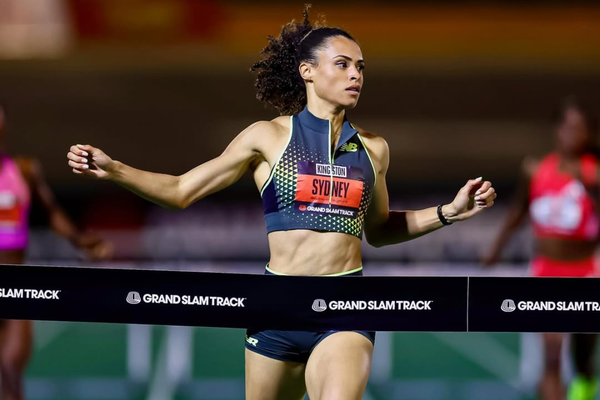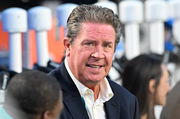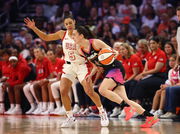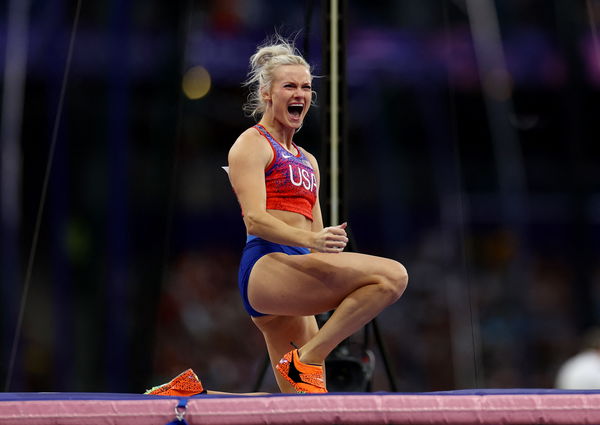
Imago
2023 World Athletics Championships Budapest Towa Uzawa JAP, Courtney Lindsey USA, Tamil Guliyev TUR, Mens 200m Qualification Heat Five, during the 2023 World Athletics Championships at National Athletics Centre, Budapest, Hungary on 23 August 2023.. Editorial use only , Copyright: xIanxStephenx PSI-17887-0412

Imago
2023 World Athletics Championships Budapest Towa Uzawa JAP, Courtney Lindsey USA, Tamil Guliyev TUR, Mens 200m Qualification Heat Five, during the 2023 World Athletics Championships at National Athletics Centre, Budapest, Hungary on 23 August 2023.. Editorial use only , Copyright: xIanxStephenx PSI-17887-0412
The Budapest World Athletics Championships of 2023 laid bare the gulf in scale between the United States and Japan on the global stage. The American squad dominated with 29 medals, 12 gold, 8 silver, and 9 bronze, while Japan managed only two podium finishes, courtesy of Haruka Kitaguchi’s javelin gold and Masatora Kawano’s 35 km race walk bronze. Those figures revealed contrasting positions for the United States and Japan.
Watch What’s Trending Now!
Yet in September 2025, the circumstances will differ dramatically. The World Athletics Championships return to Tokyo for the first time since 1991. Unlike the pandemic-disrupted Olympics four years ago, the Japanese capital will host packed stands, sweltering heat, and national expectations. Home athletes such as Kitaguchi, Kawano, and rising stars like Kiryū Yoshihide will carry hopes. For the United States, the tournament offers another opportunity to assert dominance, particularly in sprinting, relays, and field events. This time, the story is less about broad supremacy than about how the hosts can cut into the American advantage.
ADVERTISEMENT
Overall medal tally predictions: how will USA and Japan rank?
It is reasonable to project that the United States will once again top the medal standings in Tokyo. The depth of talent across sprints, jumps, throws, and relays remains unmatched. Defending champions such as Noah Lyles in the 100 and 200 meters, Ryan Crouser in shot put, and Sydney McLaughlin-Levrone, who is stepping into the 400 meters flat, exemplify a team prepared for multiple podiums. American relay squads also arrive as perennial contenders, with both men’s and women’s lineups expected to threaten world leads.

Imago
Credit: Instagram/ Sydney McLaughlin-Levrone
Japan, however, enters with clear medal prospects despite a smaller pool of world-class contenders. Home support has historically bolstered host nations, and the Tokyo meet is no exception. Kitaguchi remains the country’s foremost name. Kawano, with consistency at the global level, is a medal candidate in the 35-kilometer race walk. Sprinter Yoshihide Kiryū, now revitalized after breaking the 10-second barrier again at the Fuji Hokuroku World Trial in August, stands as the centerpiece of Japan’s sprint campaign.
ADVERTISEMENT
Which track and field events could boost team USA’s medal count?
The foundation of the American campaign lies in the shot put. Crouser, the reigning world champion and record holder, enters Tokyo with ambitions of another gold. Alongside him, Payton Otterdahl, Adrian Piperi, and Josh Awotunde, reinforce the strength of the U.S. throws squad. In women’s throws, Chase Jackson in shot put and Laulauga Tausaga in the discus defend their world titles, offering more medal potential.
ADVERTISEMENT
Sprints and relays will likely provide the largest share of US success. Noah Lyles seeks a third consecutive 100-meter crown, with compatriots Kenny Bednarek (in 100m and 200m) and Christian Coleman (part of the relay core). On the women’s side, Sha’Carri Richardson defends her world 100-meter title, supported by Melissa Jefferson-Wooden, who clocked the fastest time of 2025. The absence of Olympic 200-meter champion Gabby Thomas, ruled out with an Achilles injury, opens a gap, but the squad remains formidable. Relay events, the 4×100 and 4×400 meters for both men and women, should yield medals.
Top Stories
“Rest in Peace”: Prayers Pour In From Dan Marino as Dolphins Legend Mourns Tragedy in South Florida Football

“NFL Was Crying”: Maxx Crosby Says League Forced Him to Remove Shoes Honoring His Daughter

Florida Police Arrest Millionaire NASCAR Veteran Over Disturbing Public Misbehavior

Cam Newton Makes NFL Return Conditions Clear to 32 Teams as Panthers Legend Confirms Retirement Stance

Caitlin Clark Shows Concerning Signs vs. Kelsey Plum During USA Camp Debut, per National Reporter

Jerry Jones Reaches Breaking Point With Cowboys Coach as Matt Eberflus Receives Clear Order


Reuters
Paris 2024 Olympics – Athletics – Women’s Pole Vault Final – Stade de France, Saint-Denis, France – August 07, 2024. Katie Moon of United States reacts after her jump during the final. REUTERS/Stephanie Lecocq
Field events further strengthen US prospects. Katie Moon and Sandi Morris in pole vault, alongside Tara Davis-Woodhall in long jump, enter as consistent medal candidates. Moon is a defending world champion, and Harrison has made podiums at previous championships. American pole vaulters will share the stage with Sweden’s Mondo Duplantis, whose bid for a global title is widely anticipated.
ADVERTISEMENT
In middle-distance and hurdles, American strength remains evident. Masai Russell in the 100-meter hurdles, and Dalilah Muhammad in the 400-meter hurdles expand medal opportunities. McLaughlin-Levrone, transitioning into the flat 400 meters, is expected to be a highlight of the week. Taken together, these names underline why the United States is forecast to repeat its top finish in the medal table.
Where can Japan secure medals on home soil?
For Japan, medal hopes rest on a narrower group of athletes, but the stage provides unique conditions. Haruka Kitaguchi, despite a recent elbow injury, commands national attention. Her Budapest triumph in 2023 with a throw of 66.73 meters remains iconic, and her Olympic gold in Paris elevated her status. Ahead of Tokyo, she admitted, “Since I’ve already experienced how amazing it feels to win a gold medal, I know I love being number one. So I’m going to give it everything to be the best.” Even with recent struggles in Zurich and Lausanne, Kitaguchi’s presence is pivotal.
ADVERTISEMENT
Race walking is another avenue for Japanese success. Masatora Kawano, who won silver in Oregon in 2022 and bronze in Budapest in 2023, enters as one of the world’s best in the 35-kilometer event. His world record of 2:21:47, set at the Japan Championships in 2023, was later broken, but his consistency ensures medal contention. Reflecting on his path, Kawano stated, “I earned the right to compete at the World Championships, but I don’t see that as the goal. It’s simply the starting line.”
Sprinting adds intrigue. Kiryū Yoshihide’s return to sub-10-second form in August 2025, after years of battling health issues, provides a narrative of resilience. At 29, his experience combines with a renewed physical edge, making him a contender in the 100 meters and as part of the 4×100 relay. His words after reclaiming the national title in July, “I’ve been running track since junior high, more than ten years now. But this was the first time I’ve ever shed tears of joy”, capture the emotional momentum behind his campaign.
Middle- and long-distance events could add further medals. Nozomi Tanaka, who placed eighth in the 1,500 meters at the Tokyo Olympics, has matured since turning professional. Though she struggled in Paris, she emphasized, “To be able to race in front of a packed National Stadium here in Tokyo, I think that can be a real advantage.”
ADVERTISEMENT
Key head-to-head matchups between USA and Japan athletes
The Tokyo World championships also frame a series of direct contests between American depth and Japanese ambition. In the men’s sprints, Kiryū Yoshihide will face Noah Lyles and the U.S. relay squad. While the Americans hold clear numerical strength, the presence of Kiryū with home support could tilt the dynamics in the 4×100 final.
The women’s javelin will be one of the most closely watched duels. Kitaguchi, the reigning world and Olympic champion, confronts US throwers and other global competitors. Her return from injury adds uncertainty, yet her track record and national significance make this a centerpiece event.
ADVERTISEMENT
The 35-kilometer race walk positions Hayato Katsuki and Masatora Kawano against American entrants, though Japan has historically enjoyed the upper hand in this discipline. Kawano’s familiarity with heat management in Tokyo could prove decisive.
The 2025 World Athletics Championships in Tokyo bring the contrasts of two nations into focus. The United States arrives with the squad, capable of collecting medals across virtually every category. Japan, meanwhile, relies on a smaller circle of stars but enjoys the immeasurable advantage of competing before home supporters.
Ultimately, the medal tally may echo past championships, with the Americans well ahead. Yet the measure of Japan’s campaign lies not in surpassing the United States, but in converting national heroes into global contenders on their own soil.
ADVERTISEMENT
ADVERTISEMENT
ADVERTISEMENT
ADVERTISEMENT

